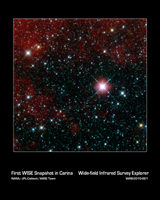
First WISE Snapshot in Carina
Click on the image for larger poster versionThis infrared snapshot of a region in the constellation Carina near the Milky Way was taken shortly after NASA's Wide-field Infrared Survey Explorer (WISE) ejected its cover. The "first-light" picture shows thousands of stars and covers an area three times the size of the moon. WISE will take more than a million similar pictures covering the whole sky.
The image was captured as the spacecraft stared in a fixed direction, in order to help calibrate its pointing system. The mission's survey will be done while the satellite continuously scans the sky, and an internal scan mirror counteracts the motion to create freeze-frame images. The team is working now to match the motions of the spacecraft and the scan mirror precisely.
This eight-second exposure shows infrared light from three of WISE's four wavelength bands: Blue, green and red correspond to 3.4, 4.6, and 12 microns, respectively.
NASA's Jet Propulsion Laboratory, Pasadena, Calif., manages the Wide-field Infrared Survey Explorer for NASA's Science Mission Directorate, Washington. The mission's principal investigator, Edward Wright, is at UCLA. The mission was competitively selected under NASA's Explorers Program managed by the Goddard Space Flight Center, Greenbelt, Md. The science instrument was built by the Space Dynamics Laboratory, Logan, Utah, and the spacecraft was built by Ball Aerospace & Technologies Corp., Boulder, Colo. Science operations and data processing take place at the Infrared Processing and Analysis Center at the California Institute of Technology in Pasadena. Caltech manages JPL for NASA.
More information is online at http://www.nasa.gov/wise and http://wise.astro.ucla.edu.

